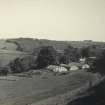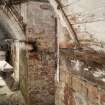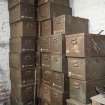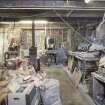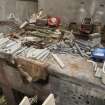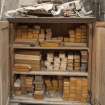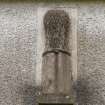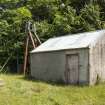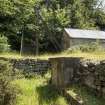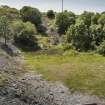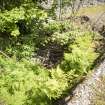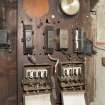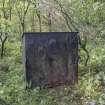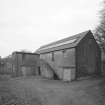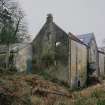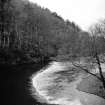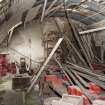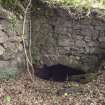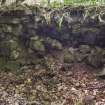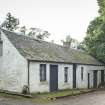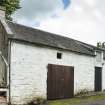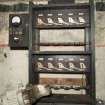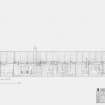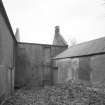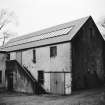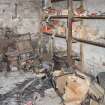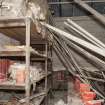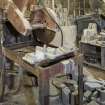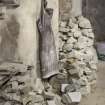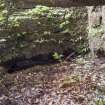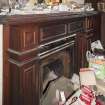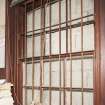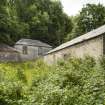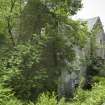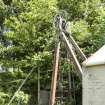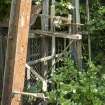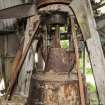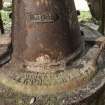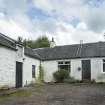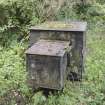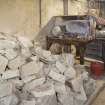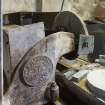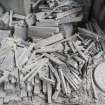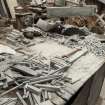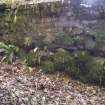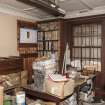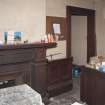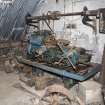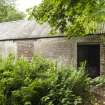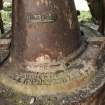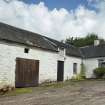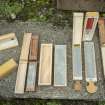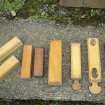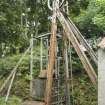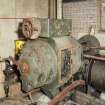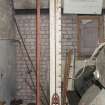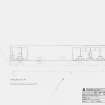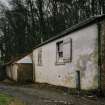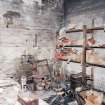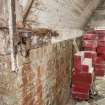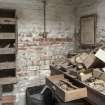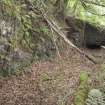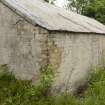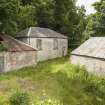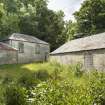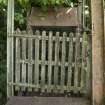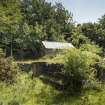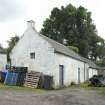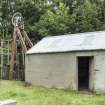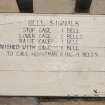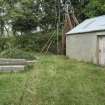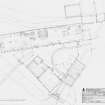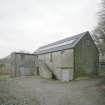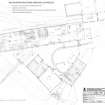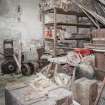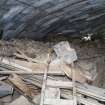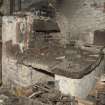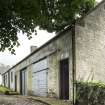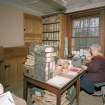Dalmore Mill, Hone Stone Works
Stone Working Site (Period Unassigned), Watermill (Period Unassigned), Works (Period Unassigned)
Site Name Dalmore Mill, Hone Stone Works
Classification Stone Working Site (Period Unassigned), Watermill (Period Unassigned), Works (Period Unassigned)
Alternative Name(s) Heron Mill; Water Of Ayr Stone; Tam O' Shanter Stone
Canmore ID 90106
Site Number NS42SW 19
NGR NS 43543 23452
Datum OSGB36 - NGR
Permalink http://canmore.org.uk/site/90106
First 100 images shown. See the Collections panel (below) for a link to all digital images.
- Council East Ayrshire
- Parish Stair
- Former Region Strathclyde
- Former District Cumnock And Doon Valley
- Former County Ayrshire
NS42SW 19.00 43543 23452
NS42SW 19.01 NS 4327 2310 Winding Engine, Chimney
NS42SW 19.02 NS 4320 2323 Stone Mine
NS42SW 19.03 NS 4330 2334 Whetstone Roasting and Grinding Mill
Photographed in February 2004 prior to proposed closure of the mill.
Information from RCAHMS (MKO), February 2004
Dalmore or The Tam o' Shanter Hone Works is situated on the S bank of the River Ayr about 240m W of the Stair Birdge (NS42SW 5). The mill complex consists of three buildings, one of which is two-storeys high and partly unroofed. The lade is still extant as a shallow ditch running between the river and the mill. The unroofed section was the result of action by vandals in 2003. Above the forestair there is a sculpture representing a sheaf of corn with the name W Heron below, dated 1821.Part of the Mill was rebuilt following destruction by jettisoned incendiary bombs in 1942 RCAHMS 2004).
Dalmore Mill is depicted as roofed on the 1st edition of the OS 6-inch map (Ayrshire, 1860, sheet xxxiv), and annotated as 'Dalmore Mill [whetstone]'. The 6-inch map shows a single block, the 25-inch map two buildings and a sluice with lade running from the mill dam about 124m to the E. By the date of the 2nd edition 25-inch (sheet xxxiv.2 ibid), there are three roofed buildings, one of which divided into three parts.
The Object Name Book (ONB) describes the works as 'A hone mill worked by water-10 horse power-two storeys high, slated and in good repair. The stone from in Dalmore Quarry is dressed and polished here. Property of William Dun Esq., Dalmore' Name Book 1857).
Visited by RCAHMS (MKO), February 2004; Information from RCAHMS (DE), January 2008
Photographic Survey (June 2013)
Photographic survey carried out during survey of site by RCAHMS in 2013. The Tam O Shanter Works at Milton (NS42SW 79) and the Water of Ayr Dalmore Mill Works on the south side of the River Ayr (NS42SW 19) were both photographed during this survey.
Information from RCAHMS (MMD), 2 July 2013.
Field Visit (June 2013)
Stair, Milton Hone Works is associated with Dalmore Hone Stone Works (NS42SW 19.00 - 19.09).
Report
Stair, Milton'Tam O'Shanter' Hone Works NS42SW 79
Background
The hone stone works at Milton (associated with trade names 'Tam O'Shanter' and 'Water of Ayr' stone) made hones or whetstones for sharpening or refining of razors, or to give a high quality polish to surfaces such as engraving plates or copper cylinders used in printing. The quarried stone used was obtained locally, although similar stones suitable for hone making were also sourced from Staffordshire, Greece and India. The hones were made from 'a baked, hardened shale ... obtained at the Sundrum Mine and Quilkiestone Mine near Stair as a hone stone or whetstone for sharpening tools...' (1) The stones processed at Milton Hone Works underwent cutting and facing (shaping rough sawn blocks into individual stones on machine tools called lathes), turning (refining of the shape of the hone stone on lathes) and polishing (on polishing machines to finish the hones prior to dispatch to customers).
By 1852 there was the 'Tam O' Shanter Hone Works' which was owned and operated by Hugh Brown (2). This was possibly sited at NS43587 23530 and may form the west end of the Milton Hone Works Main Workshop (Building 1, see site plan and section SC1365546 and SC1365546). Latterly, Gilbert MacPherson carried out the cutting and polishing of hones at the site, the business eventually being sold to John Cunninghame Montgomerie. The factory at Milton, dating from the 19th century, closed in the early 2000s.
On the opposite bank of the River Ayr, Dalmore Mill latterly (since 1940s) made smaller hones for razors, scalpels/medical instruments (these hones were known as 'microtone' hones) and jewellers. Dalmore Mill, was originally a grain mill built in 1821 by William Heron. By the 1830s it was operated as a hand, wool carding factory. (3) It is also noted that another hone works was operated in the 1820s by a Mr Smith of Mauchline at Stair. (4)
Dalmore Mill and Dalmore Mine, and the stone pulverising works (NS42SW 19.03) were also associated with the company operating at Milton. These closed around 2003. (5) From 1902, both sites were linked by a footbridge.
The Estate
In 1876 the Dalmore estate came into possession of the Montgomerie family. John Cunninghame Montgomerie married the daughter of William Dunn in 1876 and worked the quarry at Dalmore (originally opened 1789). By 1878 John Montgomerie is referred to as 'hone manufacturer Stair'. Montgomerie used the name 'Water of Ayr' and 'Tam O' Shanter' Hones for trading and in 1885 started to supply the whetstones directly to his customers (6) from Dalmore Mill.
By 1902 John Montgomerie had acquired Milton Mill and the adjoining land and was the owner of the Water of Ayr and Tam O' Shanter Hone Works Limited Co. [both the Milton and Dalmore manufacturing sites and related quarries] which was formed with the intention "to buy and otherwise acquire the business of whetstone manufacturer; stonemason and trader carried on by John Cunninghame Montgomerie of Dalmore in the parish of Stair in the County of Ayr, Dalmore, Ayrshire, and the company of whetstone manufacturers, Quarrymen and traders conducted by the firm of G[ilbert] Junior McPherson [or MacPherson] and co. Meikledale [where MacPherson had his quarry, NS44524 623063] in the parish of Stair and Enterkine [site of other quarry] in Tarbolton, Ayrshire and Glasgow; together with the goodwill and the entire property...of their respective companies". (7)
Milton Mill ceased to be a meal mill in 1902 (8) and produced power for the adjacent hone works from its waterwheel. A turbine was installed in 1935 on the site of the waterwheel to supply electricity to operate the machinery. This may be the turbine that was destroyed by floods in the 1960s. (9)
The Site at Milton (see site plan and section SC1365546 and SC1365546)
The Hone works required water to drive the machinery that made the hone stones. Milton, a hamlet some 0.4km (0.2 miles) west of the village of Stair in East Ayrshire, has been served by a mill lade for at least 200 years.
Map Evidence
The Ordnance Survey (OS) maps give a good overview of the development of the Milton site from 1857. The OS map surveyed in 1857 (10) depicted the 'Corn Mill' plus the lade, a building to the south of the lade (the masonry building which now forms the north end of the current workshop, Building 1) and the cottage row at Milton. (11)
By 1895 the main workshop had been added to Building 1 to create the main hone workshop. The water-wheel had been enclosed and the courtyard building to the south had been added (Building 2).(12) By 1908, the main workshop (Building 1A) had been extended south east towards the River Ayr by about 9.0m, the lean- to added against the north west gable of Building 1 (the masonry building), the lade centred at NS43598 23514 had been canalised and the suspension bridge of 1902 had been built. (13) By 1946 the turbine house had been constructed but otherwise the site is unchanged from the 1908 map. (14)
The east courtyard building (Building 3) is post-1946 as is the corrugated iron and steel-framed awning that covers the courtyard.
The Buildings
BUILDING 1 and 1A - Main Workshop (see SC1365546 and SC1365546, site plan and section)
The main workshop building incorporates an older masonry building (Building 1, possibly built at the same time as Milton Mill) dating from before 1957. Building 1 has had its roof replaced when the building was extended (the wall head shows remodelling, see DP161922). There is an original splayed window with its wooden frame on the north gable (see SC1363405). The double door through which stone was latterly brought from the courtyard to Saw 1 has been inserted and the upper part of the masonry wall has been removed. There is evidence of blocked windows on the west wall adjacent to the lade. Its south gable has been remodelled and the original dividing wall removed. A remnant of the wall (to roof truss height) supports the line shaft to which the lathes and saws were coupled. At the north west end the gable has been built up with brick, presumably when the main workshop was extended before 1893. The north end has an earthen floor. This building contains Saw 1 and boxes of rough stone. Building 1A is of wood (board and batten construction) on a wooden frame. It is butted against the south gable of Building 1 and was constructed between 1857 and 1893 (see Map Evidence, above). Building 1 was re-roofed with corrugated iron at some point during this period. Several of the windows and original doors have been blocked over the years, and some have been removed and the voids blocked up by the owners of the site due to vandalism.
This building contains whetstone cutting, facing, turning and polishing machines and other plant. The electric motor appears to have replaced an earlier set, judging from additional bolts visible on the upper surface of the concrete plinth on which it sits, and unrelated to the current motor set. The motor sits on a concrete plinth to cut down on vibration, to ease access for repair and for coupling (connecting) with the main drive shaft running down the centre of the workshop.
Map and physical evidence show that the building had been further extended by 9.0m (in the same construction style) by 1908. The north west wall has been rebuilt in brick after the floods of mid-1960s which destroyed the turbine at Milton Mill. The floor is of concrete and this may have been completed around the time that the courtyard was concreted over (date unknown). At the junction with Building 1 and 1A (the junction of the pre 1857 and post-1893/pre-1908 extension), there is a boarded truss of board and batten construction.
Originally the Milton Mill grain mill waterwheel and a later turbine (now removed) generated electricity for the main workshop (Buildings 1 and 1A). A turbine which replaced the Milton Mill waterwheel was installed in the lean-to building at NS43587 23539 (adjacent to Milton Mill), presumably when the lade was upgraded and the turbine house was built in the mid-1930s. It is unknown if there was an earlier turbine prior to the 1930s development.
The Line Shaft
In its current state the line shaft layout appears to be earlier than the pre-1908 extension. In the late 19th and early 20th century there was a general introduction of line shafting running from a single large electric motor to power workshops and industrial sites. The line shaft and the wheels running from it are usually of iron. The line shaft can be clearly seen resting on a remnant of the original south gable of Building 1 (DP161923, above left). There are several surviving wooden shaft wheels which would have been made when metal was scarce (such as during WW2).
The drive shaft and pulley wheel system line shaft allows machine motive power layouts can be easily modified and such modification can be seen with the insertion of Lathe 5, relocated from Engineering Shop at Dalmore Mill in the 1970s. (15) It is unclear when the current layout of machinery was adopted. The site plan shows that a few pulley wheels on the drive shaft do not now line up with machinery.
BUILDING 2
This is a two-compartment, wooden (board and batten) storage shed with open-truss, corrugated iron-covered roof (constructed after 1857 and before 1895, 14.0m in length) and a later brick-built west gable wall (replacing the original wooden gable). There is a double door for access in the north elevation at the west end, two opposing single doors in the east portion and two blocked windows (on the south elevation and east gable). Hone stones are piled up in it, which are mostly off-cuts which were exported to be used as, amongst other things, 'marble polishers' for terrazzo floors.
In the west end, there was a packing area for packing the polishing off-cuts into barrels (second hand ginger barrels were used by the Hone Works for shipping the polishing stones). Under the sawdust were kept thin pieces of stone damp for making microtome hones, (16) as dampened stone is easier to work. The floors appear to be earthen throughout, the walls sitting on the concrete apron around the building formed by the courtyard and the access area from the north bank of the river.
In the easternmost part of this building is where packed hones from Dalmore Mill (where the smaller hones were manufactured) were stored, along with Tam O' Shanter and Dalmore stone signature red cardboard presentation boxes. Long benches run below the windows and skylights to the south and east for maximum natural light.
This building appears to have been extended to the east by about 4.0m between 1908 and 1946, the chimney approximately marking where the original east gable may have been (see DP161955). The north corner of the current east gable clumsily butts up against the covered area above the lade (where the bogey carrying the stones to be steeped prior to cutting was lowered in). This contains a door which accessed the toilet block (at NS43578 23510). This structure dates from post-1946 and is also built of wood in the same style as Building 2, and connected Buildings 2 and 3.
BUILDING 3
On the eastern side of the courtyard sits Building 3 (at NS43597 23519). This was the Labelling Shed where hand hones were labelled and hones such as rubber tapping hones were packed in sawdust. The Shed contained drying racks, and had two windows on its east side, two skylight windows and a stove made by Tangye of Birmingham. This building is of wood (board and batten) with an open truss roof with a hipped north end. The plank walls were covered with tarred felt (north end) to afford some protection from the elements. This building is post-1946 and is of different construction to Building 1A, but similar in construction to the extension of Building 2 (see site plan).
COURTYARD
Map evidence seems to suggest that the courtyard area was not covered over until after 1946. The courtyard floor has been concreted over but it is unclear if it was done in the 1930s or subsequently as it butts against the suspension footbridge ramp on site and so post-dates 1902. The frame supporting the corrugated iron awning over the courtyard sits on the concrete, so the concrete is earlier than 1946.
The rails on which the stone bogey was pushed run into the lade to allow the stone to steep prior to sawing, are embedded in the concrete. Again, it is unclear when this rail arrangement was installed, but perhaps before the construction of Building 3. The lade at this point was canalised between 1893 and 1908. There is a concrete and steel plate sluice gate at NS43598 23507. The bridge which was built across the end of the lade to access the sluice gate opening mechanism is not depicted on the 1946 map and may be later.
TURBINE HOUSE
The brick and steel-framed turbine house was built in 1937 and contained a Kaplan turbine by Boving, now removed (220 volts DC output). This supplied power to the Milton site as well as to Dalmore Mine on the south side of the river. This was built at the same time as a turbine (now gone) installed at Milton Mill to operate the machinery in the main workshop.
It appears that the turbine house has been extended to the north. The north section contains switchgear and a couple of barrels used for lifting plant out of turbine house. There is a concrete machine plinth running along the north wall which had a motor generator-set on it. This provided standby power to the site if the turbine was shut down for repair. This generator was removed some time ago. The bearings from the original turbine are visible (above right, DP162004).
Water Management
There is a dam (NS42SW 68.0) with an intake in the north bank at NS4369 2363. The lade cuts off a 1.2 hectare/3 acre bend in the river and supplied the corn mill (NS42SW 80) and other businesses with water for power generation. There was work carried out in the 1890s to increase water supply, with the concrete dam serving Milton constructed at that time. It appears that the lade running through the Milton hone works was concreted during these improvements. The concrete-lined lade was again upgraded in the 1930s in order to smooth out its sides and bottom (17) to obtain a smoother water flow to the new turbine house. (18)
There is a sluice at NS43591 23541 which controlled the waterwheel at Milton Mill. This sluice also enabled water to flow into portion of the lade under Building 3, where stone was steeped prior to sawing in the main workshop of the hone works (Building 1 and 1A). This part of the lade was also concreted at the same time as the general lade remodelling upgrade in the 1890s. The remodelling is clearly shown on the 1911 Ordnance Survey map (surveyed 1908). The 1896 edition of the Ordnance Survey map does not show this remodelling (19) suggesting that the work was carried out around 1895.
PROCESS in Building 1 and 1A - Main Workshop
Refer to site plan.
Raw Material
The Dalmore blue stone (a fine mudstone/sandstone, greyish-blue in colour) as well as other stones used at the site with the properties required for making hones was mined in rough blocks (e.g. from a mine at Biddulph in Staffordshire which ceased working in the 1970s), and sent to Milton by lorry (initially by horse and cart from Tarbolton Railway Station). It was manually offloaded (from the truck/cart) onto watered planks to allow them to slip onto the ground at the north end of the factory (at NS43596 23533).
Soaking of Stone
The stone would be unloaded and taken by (latterly) a bogey on a set of rails to the Main Workshop (Building 1A) and stored around Saw 1. Occasionally the Staffordshire stone that was used was too hard to cut on the saws in the Main Workshop and so was steeped in the water of the lade. The stone would be taken out on a manually handled flat-bed bogey (now removed) on the narrow gauge rails from either of the two saws cutting the stone (Saws 1 and 2) and hand winched down into the lade.
The bogey was made on site of Scots Larch and had a hook attached onto which the winch was fixed. The stone to be immersed in the lade was held on the bogey by rope. There are two turning plates extant on which the bogey could be turned easily to supply Saws 1 and 2.
Sawing (see site plan)
The stones to be cut would, on average, measure 4ft (1.2m) by 2ft 6in. (0.76m) by 2ft (0.61m) or 50-70 lbs (22.0Kg-31Kg) in weight. These would be transported to the bench of Saw 1 and lowered into place using a block and tackle (now gone) along a running rail above the saw bench. The chain and grips attached to the block and tackle are still on site.
Once the block was on the saw bench, the sawyer had to decide how to cut it to make best use of the stone. Each block was squared off on four sides on the saw bench and then finished off on lathes (this was called facing). All the off-cuts were kept for cutting on diamond saws into blocks measuring 6in. (0.15m) by 8in. (0.20m) by 2in. (0.05m) or for rubber tapping knife hones (at Dalmore Mill across the river).
The circular saw blade of Saw 1 would have sat on the saw bench in between metal plates, with an L-shaped plate at the bottom for the stone to rest against. The saw table was moved by hand, using the hand crank. The stone to be cut was manually moved by the operator against the saw's cutting edge.
Saw 2 lies to the south and is smaller than Saw 1. The saw blade started at 36in. (0.91m) or 48in. (1.22m) malleable steel disks (from Sheffield) into which teeth were sawn on site by the saw doctor. When the saw in Saw no.1 wore down and the teeth re-cut, it was used on Saw 2 to cut smaller blocks. Such saw blades could end up 9in. (0.23m) across but still usable in the smaller saw benches at the south end of the Main Workshop.
The saw tables also have wooden 'troughs' which partially cover the belt drives from the main shaft. All pulleys are high in the centre, so they could not slip from the pulley wheels and so fingers would not be trapped in the pulley system.
There were smaller blocks of stone weighing about 20lbs (9kg). The smaller off-cuts from this were sent to the diamond saws at Dalmore Mill on the southside of the river for further working into smaller hones and microtone hones.
Facing
After the blocks were roughly cut on four faces on Saw 1 (also known as the 'Big Saw'), the blocks were taken down to Lathe 1 for 'facing off' (smoothing the faces of the blocks). This lathe is of American design and construction. All of the lathes in the Main Workshop are belt driven, the drive shaft being turned by an electric motor.
Lathe 2 is a screw cutting lathe by Dempster, Moore and Co. Ltd of Glasgow. It was used to face the round whetstones cut from the smaller pieces of the Tam O' Shanter stone (cut to size on Saw 2). The Tam O' Shanter stone came into the Workshop between Lathe 2 and the Copper (a heated metal vessel used for cleaning the smaller razor hone stones after polishing) and offloaded opposite the door at Saw 3. On the date of survey, there was a pile of Tam O' Shanter stone left un-worked at Saws 3 and 4. This lathe was also used to shape and smooth large razor hones - long flat narrow stone. These measured 15 in. (0.38m) by 6in. (0.2m) by 1.5 in. (0.04m) and were used for sharpening microtome knife blades used in hospitals for taking thin sections of tissue for microscopes.
Microtome hones were made of very fine Water of Ayr dark blue stone (a stone finer than Tam O' Shanter stone). After the loss of the polishing room at Dalmore Mill due to fire, the microtone hones were brought over to Milton for finishing in the Main Workshop at Milton.
Lathe 3 is a surfacing and boring lathe by John Lang and Sons of Johnstone, Renfrewshire. This lathe was used to shape smaller circular whetstones or wheels. (20) Lang and Sons made this lathe throughout the late 19th century and this lathe may date from the late 1890s/early 1900s.
Painting of Hone Lamination
Hones were painted to seal the sides as the whetstones are made from a sandstone which is laminated (made up of a series of strong sandstone layers alternated with weaker bonding layers) and can crack when used in water (see DP162012 below).
The painting area (see SC1363405) consisted of a wooden pivoting block mounted on a re-used ginger barrel.
Saw Doctor Area
The saw doctor's expertise was in maximising the length of use of the saw blades by re-cutting teeth and tensioning the cutting edge to give it strength.
The saw tooth punching machine was driven from the main drive shaft by belt. When in use, the punch went up and down very quickly. The saw doctor had to manually turn the saw in the punching machine, making sure that each tooth was evenly spaced around the saw edge. The sawyer also had to 'set' the teeth on the saws. Using a small tool shaped into a slight 'V' known as a saw set, the sawyer applied manual pressure to each tooth in turn around the edge of the circular saw. This would result in each tooth being set at right angles to each other to form the cutting edge.
Polishing Machines
This area of the Main Workshop is where smaller razor hones were polished. These smaller hones would have been made at Dalmore Mill and brought over via the suspension bridge (NS42SW 17). The two polishing machines appear to have been partly built on site. The large steel polishing plates would have been brought in from a Glasgow foundry such as Glengarnock (see DP162017). The operators would use a combination of skill and body weight to ensure the careful polishing of these smaller hones. This work was carried out mainly by female workers, hence the wooden stools which allowed the polisher to reach the required height to stretch over the machine during polishing.
A brick built structure containing a cast metal vessel with a firebox beneath, known as a Copper was kept boiling and next to it a byne (a Scots word meaning tub) made, in this case, from a half whisky barrel. This was situated next to the Copper. Hot water was ladled (using a long handled ladle) into the byne and the smaller polished razor hones were washed in it to remove polishing-plate dust. They were then placed on drying racks. (21) Behind the drying rack there is another saw, again belt driven, and a general grinder next to it for sharpening cutting tools. This would be have been used to grind any tools used in the hone works.
The wooden paddle was used to hold razor hones, which are a finer hone stone. They were put on the paddle, and the top surface was rubbed with another piece of stone to smooth the surface. The razor hone would then be turned and the process repeated. This smoothing process was also done for microtome knife hones. These hones were bigger, thinner and more fragile than other types of hone and were placed on a wooden paddle with a wooden lip at the end, to stop the microtome hones from slipping whilst being smoothed by hand.
All of the machinery was run off the Main driving wheel which was belt-linked to a Brookes Motor.
Acknowledgments
Many thanks to the owner of Milton Mill Hone Works, Mr Kenneth Montgomerie of Coylton for his time and patience during the survey of Milton, Dalmore Mill and the Dalmore pulverising works and to his friend Mr Scott Morrison for help with access to all aspects of the Dalmore and Milton sites.
References
(1) 'a baked, hardened shale ... obtained at the Sundrum [Dalmore]Mine [NS42SW 19.XX] and Quilkiestone [Meikledale] Mine [NS42SW 19.XX] near Stair as a hone stone or whetstone for sharpening tools...'. BGS/Scottish Government, North Ayrshire, East Ayrshire and South Ayrshire, Mineral Resources Information for Sustainable Communities, Mineral Resources, by Smith, RA;, Bide, T; Hyslop, EK; Smith, NJP; Coleman T and McMillan, AA (2008), OR/08/14 scale 1:100 000)
(2) http://bosq.home.xs4all.nl/info%2020m/grinding_and_honing_part_3.pdf, p.33 [retrieved: 12/12/2013], where indicated as 'Hone Manufacturer, Milton'.
(3) http://www.ayrshirehistory.com/ref_mills_of_the_river_ayr_hume.html [retrieved: 20 Jan. 2013], Mills of the River Ayr by JR Hume; Steps through Stair. A History of Stair & Trabboch by Derek Barber (Stair Parish Church), 19
(4) http://en.wikipedia.org/wiki/Dalmore_House_and_Estate#cite_ref-24 [retrieved: 27 Jan 2014]; In or about 1825, William and Andrew Smith of Mauchline set up a snuff box growing into the successful Mauchline Box making industry of Mauchline (Mauchline Ware, http://www.mauchlinevillage.co.uk/ware.html [retrieved: 11 May 2015]). It may be that it is one of these Mr Smiths. Razor hones were set into wooden boxes exhibiting the style of 'Mauchline Ware'.
(5) http://bosq.home.xs4all.nl/info%2020m/grinding_and_honing_part_3.pdf, 31[retrieved: 12/12/2013]; Information from owner, Mr Kenneth Montgomery, 2013
(6) Milton hone works1885 advert in the possession of Mr Kenneth Montgomerie
(7) http://bosq.home.xs4all.nl/info%2020m/grinding_and_honing_part_3.pdf, 33 [retrieved: 12/12/2013]
(8) The Last Miller: the corn mills of Ayrshire by James Pearson Wilson, Ayrshire monograph no. 23, compiled by Agnes M Wilson and Susan W Smith, 33.
(9) http://en.wikipedia.org/wiki/Dalmore_House_and_Estate#cite_ref-24 [retrieved:12/12/2013]
(10) Ordnance Survey 6-inch map, Ayrshire, survey date 1857, published 1860, sheet XXXIV
(11) This 19th century building of three compartments was remodelled c.1902 into five dwellings.
(12) Ordnance Survey 25-inch map, Ayrshire, survey date 1895, published 1896, sheet XXXIV.II and http://upload.wikimedia.org/wikipedia/commons/0/07/A_view_of_Stair_from_Dalmore_House.jpg [retrieved: 12/12/2013]: 'A View of Stair from Dalmore House' Robin Wilson family archive, c.1890 shows the row of cottages at Milton prior to remodelling in the early 20th century and the original length of the main workshop before extended in the early 20th century.
(13) Ordnance Survey 25-inch map, Ayrshire, survey date 1908, published 1911, sheet XXXIV.II
(14 ) Ordnance Survey 6-inch map, Ayrshire, survey date 1946, published 1949, sheet XXXIV.NW
(15) Information from Mr Kenneth Montgomerie, owner, 12th August 2013.
(16) Information from Mr Kenneth Montgomerie, owner, 12th August 2013.
(17) Information from Mr Kenneth Montgomerie, owner, 12th August 2013
(18) Information from Mr Kenneth Montgomerie, owner, 12th August 2013; Mr Montgomerie has the 1937 engineers drawings for the turbine house and lade profile.
(19) Ordnance Survey 25-inch map, Ayrshire, survey date 1908, published 1911, sheet XXXIV.II; Ordnance Survey 25-inch map, Ayrshire, survey date 1895, published 1896, sheet XXXIV.II
(20) The round whetstones/hones known as 'wheels' were dressed or faced on this lathe. The customers to whom they were sent would mount the wheel in a chuck of a lathe which would rotate at speed. The product to be polished would be held in the tail stock part of the lathe (opposite the chuck), traversing horizontally across the wheel secured in the chuck to polish it e.g. a copper cylinder.
The wheel would usually have a central 2in. (0.05) bore into which water was poured. The hole in the middle would allow water to be poured in to act as coolant and as a filings remover. Hexagonal cut stones were used by hand for polishing metal plates. This would carry off the copper filings from, for instance, a copper cylinder as it is polished by the wheel, minimising scratching of its surface.
(21) Mr Montgomerie thinks the drying rack in the main hone workshop dates from around 1950.
Glossary of terms in text
Byne - a Scots word for a tub or basin for holding water
Board and batten - walls of alternating wooden planks and wooden strips over joints between planks
Copper - a metal bowl (or copper) which sat in a frame usually of brick with a firebox beneath and used to boil water
Cutting - in this context, sawing large blocks into rough hone blocks
Dalmore Blue - hard baked mudstone mined at various sites. A dark stone with a distinctive pattern. Worked and sold by Water of Ayr and Tam O' Shanter hone making company at Stair, East Ayrshire
Drive Belt - a loop of flexible material used to link two or more rotating shafts
Drive Shaft - mechanical component for the transfer of torque (twist of an object about an axis) and rotation forming part of the line shaft
Facing - smoothing the faces of the rough block on a lathe
Fast and Loose - expression used when a pulley belt disengaged from a piece of machinery onto the fast and loose setting. In effect, the machine is removed from the central power transmission
Finishing - in this context cleaning, drying and painting
Hone - to hone is to sharpen, refine or perfect, and a hone (in the context of this report) is a whetstone or a stone with properties that allow the sharpening or refining of razors or to give a high quality polish to surfaces (such as engraving plates or for polishing copper cylinders)
Kaplan Turbine - propeller type water inward flow reaction turbine developed in 1913 but not in use until 1920s and a development of the more popular and earlier Francis Turbine
Lathe - a machine tool which rotates the work piece for cutting drilling, sanding etc.
Line Shaft - power driven rotating shaft for power transmission enabling distribution of power throughout an industrial complex or workshop. Power transmitted from main power source and distributed by belts and pulleys. In use from the 18th century until the introduction of small electric motors
Microtome Hone - specialist hone for sharpening medical microtome knives used in cutting thin sections
Polishing Machine - at Milton Mill a machine incorporating horizontal mechanically driven plates of steel onto which polishing powders added and object to be polished is moved at right angles to the circular movement of the plate. Also known as a lapping machine
Pulley Wheel - a wheel made of any material on an axle that supports a belt along its circumference. Part of the line shaft
Saw Doctor - makes, repairs, sharpens and maintains a range of cutting tools and saw blades
Saw set - tool used in the sharpening of saw blades
Sawyer - someone who saws material e.g. wood, stone using specialist tools and machinery
Tam O'Shanter Stone - a hard baked mudstone mined in Ayrshire and worked and marketed under that name by the Water of Ayr and Tam O'Shanter hone making company once based at Stair, East Ayrshire
Turbine - rotary mechanical device using energy from fluids to convert into work
Water of Ayr Stone - a particular mudstone used for hones mined and quarried in Ayrshire from at least the 16th century
Visited by RCAHMS (MMD), 2013.
Publication Account (2014)
From New Statistical Account (NSA, 1845)
"In the lands of Dalmore, upon the banks of the River Ayr, is a species of whetstone, well known in the country by the name of Water-of-Ayr stone. For several years, both the raising and dressing of the stone has been conducted with much greater care and neatness than formerly. There are two men almost constantly employed; the one in stripping and polishing, (both of which operations are performed by machinery), the other in the quarry, or in performing whatever else may be necessary. Besides what is disposed of in the home market, there is a very considerable quantity exported. The stone is 40 feet under cover. The dip and rise is on east and west direction...".
NSA, 1845, vol. V, Parish of Stair
Information from Survey and Recording Section, Industry and Architecture (M. McDonald), HES, 2014.
Field Visit (2 March 2021)
The Quarry and Mine
The quarry and mine are no longer in use. The Dalmore Quarry which supplied the hone works, and later the mine adjacent, supplied the good quality Tam O'Shanter fine hone stone. There were also hone stone quarries at Quilkieston (NS433230, aka Meikledale 'Water of Ayr' stone) and Enterkine (dark blue Water of Ayr stone - worked by the Smith family of Tarbolton until around the early 20th century). One G Junior McPherson operated this quarry by 1900 with confusion resulting from the mutual use of 'Water of Ayr' as a trade name for different quality hone stones. Dalmore quarry produced the Tam O'Shanter stone which was finer and sold to furniture makers and jewellers and watchmakers etc.
The Quarry at Dalmore is said to have been worked since the late 18th century. The OSA states "In the lands of Dalmore...there is a species of whetstone, well known in the country as Water of Air Stone...it has been exported to different parts of Europe and America and has been found preferable to any other stone for sharpening edge tools.." (see OSA, 1791-99, vol. 6, p.114). It may be that this refers to the Dalmore Quarry rather than the others in the vicinity. By 1839 it is noted that:
For several years, both the raising and dressing of stone have been conducted with much greater care and neatness than formerly. there are two men almost constantly employed; the one in stripping and polishing, (both of which operations are operated by machinery), the other in the quarry ...there is a very a considerable quantity exported... (see NSA, 1841, vol. 5, p. 638)
By 1857 the quarry covered some 5000 sq. metres and by 1895 it covered an area of 12,000 sq. metres. This appears to have been the extent of the quarrying. The quarry was filled in with waste hone stone which was in turn recycled in the pulverising mill which was built in 1916.
The shaft was sunk in around 1870 to enable the exploit another seam of Tam O'Shanter stone. Another shaft was sunk to the south of this which was named and depicted as 'Sundrum Mine' on the OS 2nd edition map.
The headgear and later winding house survive for the mine shaft at NS43209 23234, the other shaft having been filled and the building demolished sometime in the 1960s (NS43270 23102).
Mineral Tramway
There is no tramway shown on the Ordnance Survey 1st edition map, but by1895 the tramway ran from Sundrum Mine (NS43270 23102) to the quarry (a distance of about 138 metres, and possibly about 20-inch gauge as used in the mine) tipping mine waste into the quarry at its south end. The tramway also ran from the northern shaft at NS43204 23240 for 475 metres to Dalmore Mill with hone cutting at ground floor level adjacent to the east courtyard. It is said that the tramway was abandoned in the 1940s (information from Mr Montgomerie, August 2013) with horse drawn carts and lorries used thereafter to move material from the mine to Dalmore Mill for dressing and on to customers by road and rail.
Field Visit
See also:
Canmore Id: 90106 NS42SW 19.00 Dalmore Mill, Water of Ayr Hone Stone Works
Canmore Id: NS42SW 19.01 Chimney
Canmore Id: NS42SW 19.02 Winding Gear
Canmore Id: 201938 NS42SW 19.03 Stone Roasting and Grinding Works
Canmore Id: NS42SW 19.04
Canmore Id: 331379 NS42SW 19.05 Lade
Canmore Id: NS42SW 19.06
Canmore Id: NS42SW 19.07 Winder House
Canmore Id: NS42SW 19.08 Adit (stone mine)
Canmore Id: NS42SW 19.09 Powder Magazine
Canmore Id: 42762 NS42SWSW 17 Suspension Bridge (connecting Dalmore and Milton Sites)
Dalmore Mill ('Water of Ayr') Hone Stone Works (formerly known as Heron's Mill) was latterly owned by Kenneth Montgomerie. The family also owned the Milton Mill ('Tam O'Shanter') Hone Stone Works. Both sites had been closed for some years by the date of visit in 2013.
Dalmore Mill has a date stone of 1821 (corn sheaf date stone survives) and was possibly built by one William Heron. By 1857 it was described as a hone mill. The 1821 building is in a ‘T’ configuration, built of rubble with fine quoins and is of two storeys with wet harling or rendering and a forestair on the west elevation of the 'tail' of the 'T' shape of the building. It covers an area of approx. 174 sq. metres. The Dalmore Mill site was still occupied in 2004, but had been disused for some years by the time of survey (June 2013).
Dalmore Mill was hit by an incendiary bomb and burnt internally c.1940 with only the external walls surviving. It was rebuilt internally and reroofed in the late 1940s. Prior to closure (after 2004) the ground floor was used for cutting smaller hones on the diamond saws (all American, bar two), the upper floor was used by the carpenter to make hone boxes for the smaller hones - larger industrial whetstones were made at Milton Mill on the north side of the River Ayr. Cardboard boxes were also used to hold small hone stones. The building we see now has a concrete floors and ceiling. The corrugated iron roof is reinforced with tarred felt. The polishing department also located within the original mill was gutted by fire in the early 2000s and polishing was relocated to Milton Mill across the River Ayr. The polishing machines would have originally been water powered. Due to the dangerous condition of the buildings, inspection of the former polishing department was not possible on the date of survey.
The machinery in Dalmore Mill is of a post-war period and are mostly diamond cutting saws for fine cutting of hones. The carpenter shop on the first floor also has some small electrically driven table saws for making wooden hone presentation boxes. The engineers shop contains a lathe and its line shaft. It would appear that the original machinery was lost in the bombing.
South Range and Office
The former sawing area which housed the band saw for hone box making to the south of Dalmore Mill is now in a state of decay. This building was extended from some 48 sq. metres in 1857 to 176 sq. metres by 1895. The original north elevation was incorporated into the larger structure. The remains of the band saw are visible, but the building is too dangerous to enter. A large pile of waste hone sits in this building at its west end.
The Office (approx. 48 sq. metres in area; built between 1857 and 1895, although different style from the adjacent building and may be nearer to 1890 in date) to the west and butting against the former wood store is no longer in use but is secured.
East Range
The east range (approx. 27.5 sq. metres; built between 1857 and 1895) is of brick, with an open- truss structure supporting a corrugated-iron roof. It is divided into three compartments for storage and labelling of the individual hones. This block also has two chimneys for coppers – hot water was used to identify damaged hone stones. The interior walls have been painted white to reduce the amount of dust gathering and to increase natural light levels.
The northern compartment contains a copper and sinks - this area would have been for washing and drying the smaller hones as at Milton Mill. The only natural light would have come through roof lights and the doors in its west and north walls when open. This compartment affords access to the lade on the east gable of the main mill building. The room adjacent which had its own (now blocked) window, was an office or labelling area for the stones when washed and dried. A drying rack survives and a glue pot for labelling.
The compartment to the south was a storage area with a large blocked window and ingress from the east courtyard. Shelving still survives in this area which with dimension sizes for the hones stored there was still visible. Based on OS map evidence, this area was built between 1857 and 1895
Packing Shed
This is a brick-built, corrugated-iron roofed, single pitched roofed building built between 1857 and 1895, covering approx. 134 sq. metres. This was split into two compartments - the south compartment was in use as Mr Montgomerie's workshop. This is connected to the storage shed adjacent where larger industrial hones were stored according to size.
Storage Shed 1 and Engineers Workshop
This is divided into two compartments and is connected to the Packing Shed to the east, covering approx. 160 sq. metres. It has a block built south wall (possible originally wooden as with shed 2) and the south compartment contained the engineer’s workshop with its own electrically driven belt drive. Here all the general engineering work for Dalmore and Milton sites was carried out. The north compartment was used for painting and storing large industrial whetstones made at the Milton site. Based on OS map evidence, this was built between 1857 and 1895.
Storage Shed 2
This is of wooden construction with a corrugated iron roof and an open north end. Covering an area of approx. 208 sq. metres, it was used for general storage of waste hone material and packing boxes in the form of ex-army wooden munitions boxes. These were cut down and reused as they were sturdy enough to ship the fragile hones to customers. Based on OS map evidence, this was built between 1857 and 1895.










































































































